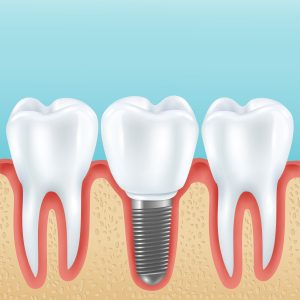Dental implants were invented in 1952 by a Swedish orthopedic surgeon called Per-Ingvar Brånemark. Today, dental implants are considered the standard of care for prosthetic replacement of missing teeth in dentistry. A dental implant is a surgical fixture that is placed into the jawbone and acceded to merge with the bone over the span of a few months.
Most dental implants are made of titanium, which allows them to consolidate with bone without being recognized as a foreign object in our mouth.
A dental implant could be a time-consuming process, depending upon the following factors-
- Your dental health
- The number of teeth involved
- Which teeth are to be replaced
- If there is a tooth to be extracted prior to implant placement

These factors will also decide the total number of visits to the dentist throughout the treatment period. For instance, a single tooth implant surgery can take one to two hours from start to finish. This includes time for anesthesia and dressing the patient for a sterile surgical condition.
Over time, technology and science have progressed to improve the outcomes of dental implant placement. However, it’s estimated that about 5 to 10 percent of dental implants fail, either shortly after the procedure or months or years later.
There can be a number of long term problems when it comes to the dental implant. Some of them are-
- Inappropriate Placement
Nerve or tissue damage may arise when a surgeon places an implant too close to a nerve. Signs of damage include numbness or tingling in the tongue, lips, gums, or face.
- Signs of Rejection
Foreign body rejection doesn’t occur often but there is a possibility. This is when the body cannot adjust with an implant. Signs of rejection include increased pain at the implant site, swelling, fever and/or chills.
- Perforation
During the procedure to place a dental implant in the jaw, some of the nearby anatomic structures are seldom injured. If the maxillary sinus cavity is perforated by the implant then it would lead to sinus issues and infections in the area in the future.
- Excessive Bone Loss
Excessive bone loss in the area of the dental implant can reduce the sturdiness of the implant replacement and usually requires meddling. Bone loss between the implants and natural teeth can also lead to the appearance of black triangles between the teeth
Factors that can cause dental implant failure are-
- Gum Disease
Gum disease is an infection that can damage the gums and jaw bone. An untreated infection could develop around the implant and lead to a disaster.
- Smoking
Smoking can also result in dental implant failure because it restricts blood flow to the gums, which slows the healing process.
- Insufficient Jaw Bone
Without enough healthy bone, the surgeon cannot surgically place the implant into the jaw.
- Poor Dental Maintenance
The ability to practice good oral hygiene after a dental implant also has a repercussion on the success rate.
Your new implant tooth must be checked regularly, just like your natural teeth. Therefore it’s very important to select a good surgeon to get your implants done in order to reduce the chances of failure. For more information, feel free to contact us now!



